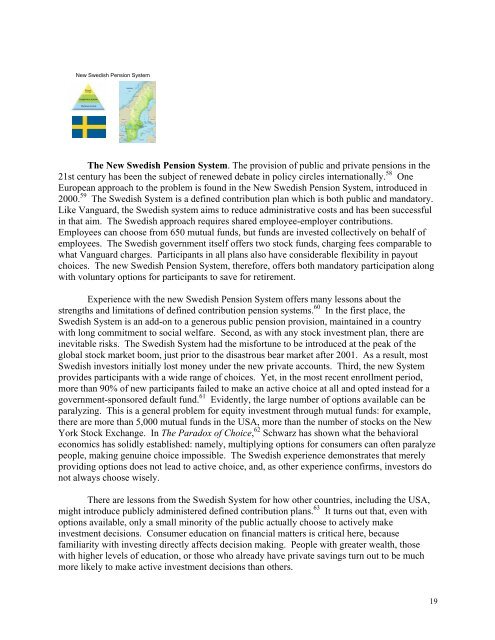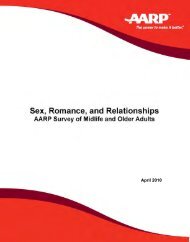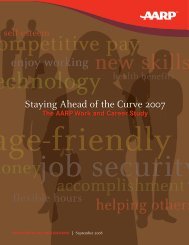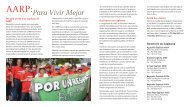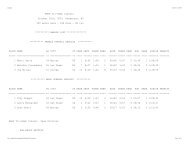The New Aging Enterprise - aarp
The New Aging Enterprise - aarp
The New Aging Enterprise - aarp
You also want an ePaper? Increase the reach of your titles
YUMPU automatically turns print PDFs into web optimized ePapers that Google loves.
<strong>New</strong> Swedish Pension System<br />
<strong>The</strong> <strong>New</strong> Swedish Pension System. <strong>The</strong> provision of public and private pensions in the<br />
21st century has been the subject of renewed debate in policy circles internationally. 58 One<br />
European approach to the problem is found in the <strong>New</strong> Swedish Pension System, introduced in<br />
2000. 59 <strong>The</strong> Swedish System is a defined contribution plan which is both public and mandatory.<br />
Like Vanguard, the Swedish system aims to reduce administrative costs and has been successful<br />
in that aim. <strong>The</strong> Swedish approach requires shared employee-employer contributions.<br />
Employees can choose from 650 mutual funds, but funds are invested collectively on behalf of<br />
employees. <strong>The</strong> Swedish government itself offers two stock funds, charging fees comparable to<br />
what Vanguard charges. Participants in all plans also have considerable flexibility in payout<br />
choices. <strong>The</strong> new Swedish Pension System, therefore, offers both mandatory participation along<br />
with voluntary options for participants to save for retirement.<br />
Experience with the new Swedish Pension System offers many lessons about the<br />
strengths and limitations of defined contribution pension systems. 60 In the first place, the<br />
Swedish System is an add-on to a generous public pension provision, maintained in a country<br />
with long commitment to social welfare. Second, as with any stock investment plan, there are<br />
inevitable risks. <strong>The</strong> Swedish System had the misfortune to be introduced at the peak of the<br />
global stock market boom, just prior to the disastrous bear market after 2001. As a result, most<br />
Swedish investors initially lost money under the new private accounts. Third, the new System<br />
provides participants with a wide range of choices. Yet, in the most recent enrollment period,<br />
more than 90% of new participants failed to make an active choice at all and opted instead for a<br />
government-sponsored default fund. 61 Evidently, the large number of options available can be<br />
paralyzing. This is a general problem for equity investment through mutual funds: for example,<br />
there are more than 5,000 mutual funds in the USA, more than the number of stocks on the <strong>New</strong><br />
York Stock Exchange. In <strong>The</strong> Paradox of Choice, 62 Schwarz has shown what the behavioral<br />
economics has solidly established: namely, multiplying options for consumers can often paralyze<br />
people, making genuine choice impossible. <strong>The</strong> Swedish experience demonstrates that merely<br />
providing options does not lead to active choice, and, as other experience confirms, investors do<br />
not always choose wisely.<br />
<strong>The</strong>re are lessons from the Swedish System for how other countries, including the USA,<br />
might introduce publicly administered defined contribution plans. 63 It turns out that, even with<br />
options available, only a small minority of the public actually choose to actively make<br />
investment decisions. Consumer education on financial matters is critical here, because<br />
familiarity with investing directly affects decision making. People with greater wealth, those<br />
with higher levels of education, or those who already have private savings turn out to be much<br />
more likely to make active investment decisions than others.<br />
19


